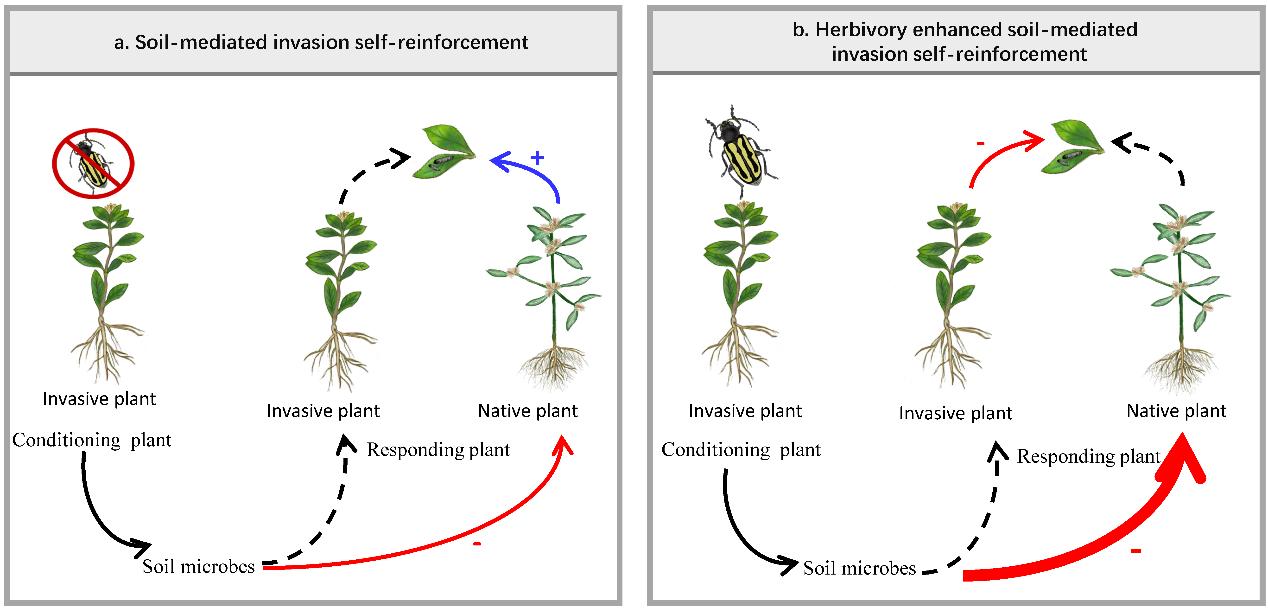南湖新闻网讯(通讯员 高伦伦)近日,我校植物科学技术学院、农业微生物国家重点实验室、湖北洪山实验室PI卢新民课题组整合多年的野外调查和土壤反馈实验,首次提出了昆虫和土壤生物协同促进植物入侵的新假说(Enhanced soil-mediated invasion self-reinforcement upon herbivory hypothesis)。该成果以“Aboveground herbivory can promote exotic plant invasion through intra- and inter specific aboveground-belowground interactions” 为题在线发表于New Phytologist杂志。
外来物种入侵严重威胁农业安全、生态安全和国家安全,有效遏制外来物种入侵是乡村振兴战略的一个重要内容,而明确外来物种入侵机制是实现这一目标的基础。学术界普遍认为逃逸了原产地专一性天敌的调控是外来植物成功入侵的一个重要原因。据此,人们通过引入和释放专一性天敌防控入侵植物(即生物防治)。然而,实践中一些天敌虽然严重危害靶标植物却未有效抑制靶标植物入侵。此外,虽然遭受严重的本土天敌危害,一些外来物种仍能成功入侵。这表明在天敌危害的情况下,一些其他的机制可能促进了植物入侵,但目前尚缺乏探讨。
喜旱莲子草 (Alternanthera philoxeroides)是我国首批公布的入侵物种之一,也是农业上一种重要恶性杂草。课题组前期分别探讨了植食性昆虫和土壤生物对喜旱莲子草入侵的调控作用(ISME Journal 2018; Annals of Botany 2021)和其生物防治对气候变化的响应(Global Change Biology 2013; Ecology Letters 2015)。在此基础上,2017-2019年课题组开展了大尺度调查,与前期结果比较发现,在2014-2019年间,引入天敌莲草直胸跳甲(Agasicles hygrophila)种群明显向高纬度地区扩散,对喜旱莲子草和本土植物莲子草(A.sessilis)的危害加剧;同时,入侵群落中喜旱莲子草的竞争优势未发生变化,且莲子草被引入昆虫危害的风险较高。

图1 无(a)和有(b) 昆虫取食时,土壤生物对入侵和本土植物、昆虫幼虫的影响。图中蓝色实线表示促进作用,红色实线表示抑制作用,线的粗细表示相对作用强度。
为探究上述现象发生的原因,课题组采用土壤生物-植物-昆虫互作循环(plant-soil feedback loop)新框架开展了实验研究。经研究发现,昆虫取食改变了植物根际微生物组结构,延长了喜旱莲子草根际生物对莲子草的不对称抑制作用,同时,被取食喜旱莲子草根际土壤提高了后期同种植株抗虫水平。据此,课题组提出了Enhanced soil-mediated invasion self-reinforcement upon herbivory hypothesis(图1),丰富了现有物种入侵理论。本研究也揭示了一种全新的生物防治非靶标风险,为完善现有生物防治实践提供了依据 (即释放生防天敌前,需综合考察其对地上和地下生态系统的影响)。
课题组博士生高伦伦、韦春强、何一凡为论文共同第一作者,卢新民教授为论文通讯作者,河南农科院武予清研究员参与了项目研究,德国康斯坦茨大学和荷兰瓦格林根大学Rutger A. Wilschut博士参与了文章撰写。该研究得到科技部“十四五”重大项目、国家自然科学基金、中央高校基本科研业务费等项目的资助。
审核人:卢新民
【英文摘要】
•Aboveground herbivores and soil biota profoundly affect plant invasions. However, how they interactively affect plant invasions through plant-soil feedbacks (PSF), remains unclear.
•To explore how herbivory by the introduced beetle Agasicles hygrophila affects Alternanthera philoxeroides invasions in China, we integrated multi-year field surveys and a two-year PSF-experiment, in which we examined how herbivory affects PSFs on the performance of native and invasive plants and the introduced beetles.
•Despite increased herbivory from A.hygrophila, A. philoxeroides dominance over co-occurring congeneric native A.sessilis remained constant from 2014 to 2019. While occurring at lower abundances, A.sessilis experienced similar herbivore damage, suggesting apparent competitive effects. Our experiments revealed that herbivory on A. philoxeroides altered soil microbial communities, prolonged its negative PSF on A.sessilis and decreased A. hygrophila larvae performance on the next-generation invasive plants. Consequently, A. hygrophila larvae performed better on leaves of natives than of invasives when grown in soils conditioned by invasive plants defoliated by the introduced beetles.
•Our findings suggest that aboveground herbivory might promote rather than suppress A. philoxeroides invasion by enhancing its soil-mediated self-reinforcement, providing a novel mechanistic understanding of plant invasions. These findings highlight the need to incorporate an aboveground-belowground perspective during the assessment of potential biocontrol agents.
【论文链接】

